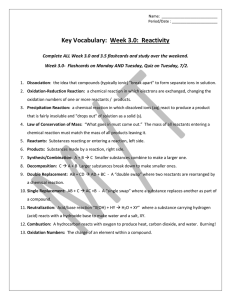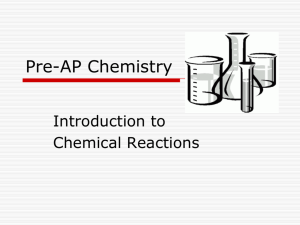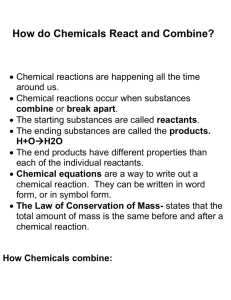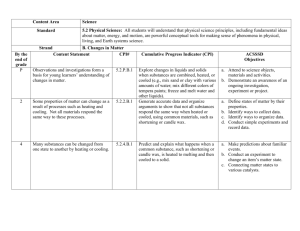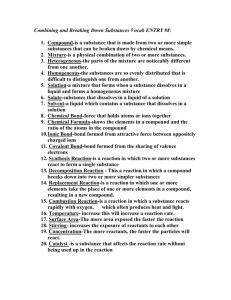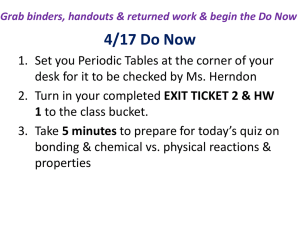Chemical Reactions: Types & Energy - High School Chemistry
advertisement
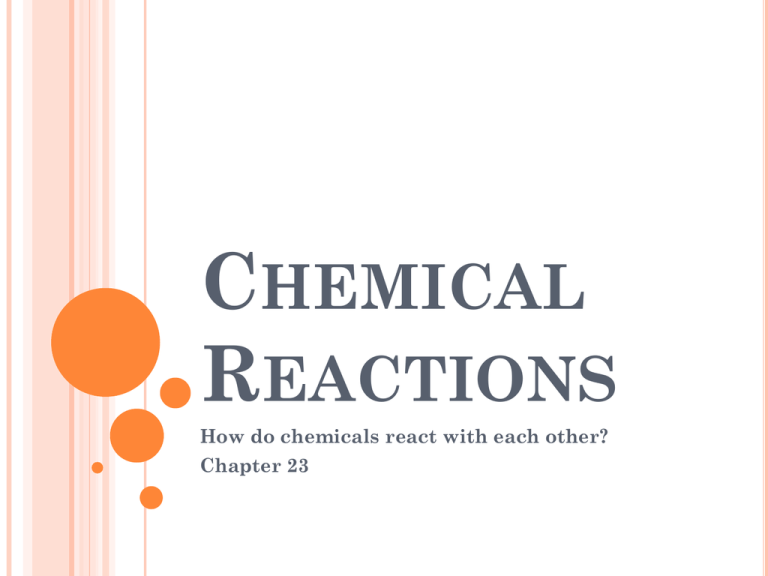
CHEMICAL REACTIONS How do chemicals react with each other? Chapter 23 WHAT IS A CHEMICAL REACTION? Atoms change identity A change of color is almost always present Cold packs, light sticks Usually gas is given off Cu replaces Ag and turns solution blue All chemical reactions give or use energy Mg atom becomes Mg+2 Form bubbles Precipitate is formed Like a snow globe, flakes of a solid Any of these signs indicates a reaction. WHY DO THEY OCCUR? Chemical reactions occur between atoms in order to form a bond Bonds form in order to complete the outermost energy shell and become less reactive, ions CHEMICAL REACTIONS A chemical reaction is an expression in which symbols and formulas are use to represent a chemical reaction. Reactants are written on the left, and products are written on the right side of the yield sign () There are some equations that are written to express reactions that never complete, they use reversible arrows CHEMICAL REACTIONS (RXNS) Begin with reactants and end with products Reactants --- Products A + B AB We aren’t creating or destroying atoms, only rearranging them (Law of Conservation of Mass) RATE OF CHEMICAL REACTIONS The rate of a chemical reaction is a measure of how quickly reactants turn into products Increasing these factors will increase the rate of reaction: A catalyst is a substance that increases the reaction rate of a reaction without itself being changed by the reaction, Ex) enzymes Speeds up and slows down a reaction EXAMPLE Isooctane, C8H18 and oxygen, O2 react to form CO2, carbon dioxide and H2O, water C8H18 + O2 CO2 + H2O + Energy KEY WORDS React with, combine with, and + To form, yields, forms, produces, creates It takes energy to break a bond (heat, electric, sound, light) – can all transfer energy Forming bonds releases energy Both result in either a endothermic or exothermic reaction ENERGY CLASSIFICATIONS Endothermic Energy is absorbed from surroundings Exothermic Energy is given off from rxn ACTIVATION ENERGY The energy required to start a reaction CHEMICAL ENERGY Energy stored in chemical bonds Released with a reaction Ex) bonds in coal store energy that is released CHEMICAL REACTION TYPES Synthesis – at least two substances form a new, more complex compound Always combine substances to form more complex substances Ex) A + B + C ABC Ex) Na + Cl2 NaCl Decomposition - Complex compound breaks down into simpler compounds - Ex) DeFG DeG + F Ex) 2H2O 2H2 + O2 (electrolysis of water) Combustion - - - Uses oxygen as a reactant and products will contain oxygen somewhere, usually as CO2 A reaction where a compound and oxygen will burn Ex) CH4 + O2 CO2 + H2O Methane combines with oxygen and activation energy to burn and produce carbon dioxide and water with light/heat Single - - - Displacement Reaction in which one element will replace atoms of another element in a compound (especially within the same family) More reactive elements will take the place of less reactive ones Ex) 3CuCl2 + 2Al 2AlCl3 + 3Cu Copper chloride combines with aluminum to produce aluminum chloride and copper ions - The aluminum replaced the copper Double - - - Displacement Two compounds exchange ions (they swap partners) Ex) Pb(NO3)2 + K2CrO4 PbCrO4 + 2KNO3 Lead nitrate combines with potassium chromate to form lead chromate and potassium nitrate. REDUCTION/OXIDATION REACTION (REDOX RXN ) A reaction that occurs when electrons are transferred between reactants One or more reactants is reduced and one or more is oxidized Reduced- substances that accept e Oxidized- substances that give up e OIL RIG: Oxidation Is Loss; Reduction Is Gain • OR LEO says GER: Loss of Electrons is Oxidation and Gain of Electrons is Reduction SUMMARY OF RXN TYPES Synthesis Decomposition AB + O2 A + BO2 Single Displacement DEF D + E + F Combustion A + B AB XA + B BA + X Double Displacement AX + BY AY + BX
